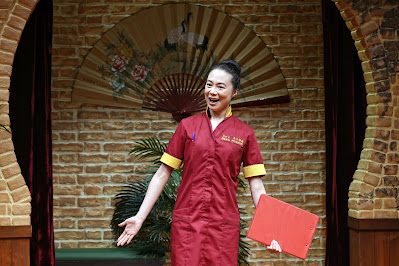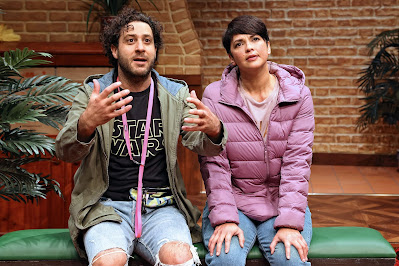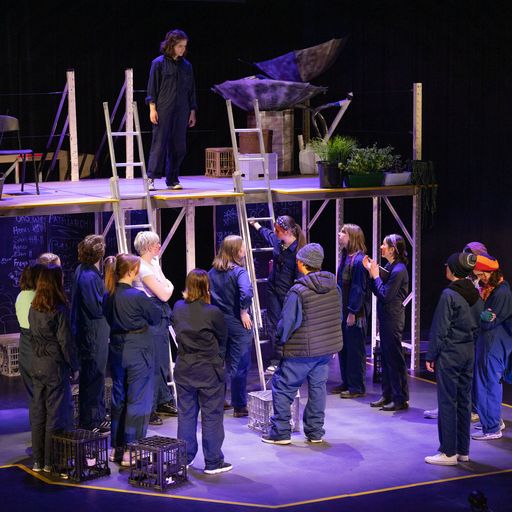 |
Cover design: Katy Wall
|
An Eye for Talent – A life at NIDA by John Clark. Coach House Books, Currency Press, Sydney, 2022.
Foreword by editor Nick Parsons. www.currency.com.au
Contact: enquiries@currency.com.au
Reviewed by Frank McKone
We critics indulge in our feelings
in response to what actors do to entertain us, but how much do we
understand about how great actors – so many of whom have been trained at
NIDA – create our sense of satisfaction, gain our appreciation and our
applause for their work?
John Clark served on the staff of the
newly established National Institute of Dramatic Art from 1960 until
1969 when he was appointed director, a position he held until his
retirement at the end of 2004. This record of his forty-four year life
at NIDA explains why the way actors are taught there has made NIDA
recognised as arguably the best drama school in the world. This is not
boasting like Bottom in A Midsummer Night’s Dream. It’s because NIDA actors are taught how to think their way into creating the feelings we respond to.
I
never went to NIDA. After all, surely my only sensible choice in 1958
was the prestigious University of Sydney; definitely not that upstart
technical college now called the University of New South Wales. Yet, by
some kind of osmosis, my thoughts on drama turned out to be much more
in tune with what Robert Quentin had in mind as the just-appointed
director of a school for actors at UNSW, which became NIDA, than with
the only drama activity at Sydney, where the Sydney University Drama
Society (SUDS) were focussed on presenting melodramas. There was no
undergraduate course in drama, so I took up politics with the Labour
Club instead.
My reviews since retiring from teaching, published
here, show my long-abiding interest in George Bernard Shaw from my
teenage days and my Masters thesis (1972). Now John Clark reveals an
amazing link to Shaw, Pygmalion and the My Fair Lady
movie I saw in 1958, on Page 207-8. Clark had earlier explained that
his approach had long been opposed to the American Method actor
training, where actors were to focus their characterisation work on
their own experience of feelings. He had them research their character, and that character’s social and even political world, and then to focus on thinking
about how that character would behave – and in this way create that
character’s feelings which are communicated to the audience.
This
means that the actor-in-training, though learning skills of voice and
movement, does not then ‘obey’ her teacher/director but through research
and thinking becomes an independent creator of the character. The
teacher is successful when the student no longer needs direction. Here
is Clark’s example:
Acting remained the
central course. It set out to teach young artists how to transform their
voice, their body, their emotional life and their thinking according to
the demands of the character they were playing and the play’s imaginary
world – exactly what Professor Henry Higgins tries to achieve in George
Bernard Shaw’s Pygmalion. Shaw knew what acting was all about; a
performer himself, he also taught acting at the London Royal Academy of
Dramatic Art and bequeathed the rights to his best-known play to his old
school. The difference between the ending of the play and the ending of
the musical adaptation is striking.
My
Fair Lady ends with a blazing row between teacher and student. Eliza
storms out, but not for long. She returns to Professor Higgins and the
implication is they will marry and live happily ever after. The play
ends differently. Eliza says to Higgins, ‘You can’t take away the
knowledge you gave me … ! I’ll go and be a teacher … what you taught me …
phonetics’. Higgins is thrilled. This is exactly what he wanted to
hear. ‘Five minutes ago, you were like a millstone around my neck. Now
you are a tower of strength.’
Throughout An Eye for Talent,
as we find out about what happened to NIDA from its Tin Shed days to
Clark’s retirement when “Astonishingly, less than 50 years from its
inception, NIDA was included in the International Theatre Institute’s
list of the ten best theatre schools in the world”, you will find
stories and comments on the process of theatre work which will surely
make connections for you – whether as performer, audience member, as
teacher, or even as reviewer.
Two Canberra connections, for
example, are Karen Vickery, very prominent currently at The Hub, and Ken
Healey, one time reviewer for The Canberra Times. Both were graduates who later taught Theatre History and General Studies at NIDA in John Clark’s time.
Ken
reviewed me – before he taught at NIDA. He observed one of my group
improvisation classes at Hawker College and gave me the title “The
Invisible Man” because, once the action was set up and underway, I had
disappeared behind the curtain to watch without interfering in the drama
being created by the students. For me, a Professor Henry Higgins
moment.
Though I had not gone to NIDA I had been to World
Education Fellowship summer schools in movement and improvisation with
the indomitable Margaret Barr in my early years of teaching (English, of
course, before Drama became a separate subject). Clark writes
Margaret
Barr reminded me of Bertolt Brecht’s Mother Courage, charging through
life with a single-minded, ruthless determination to survive…. What
mattered to her was the human body and its capacity for supple,
expressive and dynamically energetic movement. She despised prettiness,
elegance, lightness and grace. The body had weight and substance and,
unlike in classical ballet, the floor was the actor’s best friend. Her
morning exercises would have exhausted the Australian rugby football
team. Miss Barr also taught Improvisation: acting exercises without a
script that encouraged young actors to create directly from their own
experience; to think, imagine and feel from the heart, rather than
‘having plays thrust upon them’, presumably by directors and teachers of
Theatre History [ie John Clark at that time]. So much of what she
taught was fundamental to good acting: truthfulness, honesty, simplicity
and clarity. She detested pretence, emotional demonstration and
generalized acting. Everything the actor did had to come from an inner
impulse: what she called ‘the inward motivation of the outward gesture’.
Apart from personal lucky links of this kind, An Eye for Talent
is hugely informative about the experiences, backgrounds and future
lives of hundreds of the actors, production students and directors who
‘got into NIDA’ – so often against the wishes of their parents, as Clark
recalls:
Perth-born Jason
Chan wanted to become an actor after leaving school, but his parents
were opposed, so he studied medicine and became a doctor like his
father. Only then, having fulfilled his parents’ wishes, did he audition
successfully for NIDA, paying his way by doing locums each weekend. His
first acting job was in Spain with Playhouse Disney presenting
children’s television programs for Asia. He then became the Green Power
Ranger and now has his own film production company in Singapore.
Stories
like this provide us with an understanding of the changing times not
just in Australian theatre but in Australia, from White Australia to
Multicultural Australia, and at last to the increasing acceptance and
appreciation of Indigenous Australia.
The 14th Chapter is titled with a quote from Twelfth Night: Foolery Doth Walk About The Orb.
Like all good drama the through-line has to reach some kind of
climactic point. Clark had announced his intended departure as Director
some years before 2004 to allow for finding a suitable replacement, but
he remained a Member of the NIDA company. What can only be called the NIDA Tragedy of Governance following his retirement is dramatic reading indeed.
Of course, the drama e non finita.
A takeover of the Board by business and academic interests, rather than
experienced theatre practitioners operating as an arts-centred
organisation, may be working to a dénoument after catastrophe, as NIDA
reported on 4th May 2020:
NIDA
has been ranked in the top 5 of The Hollywood Reporter’s world’s best
drama schools for an undergraduate degree. The Reporter’s international
ranking of acting schools places NIDA in the top echelons, along with
Carnegie Mellon and New York’s Juilliard School.
The Hollywood
Reporter canvassed alumni, instructors and top theatre and Hollywood
pros to arrive at its list. The stringent ranking took into account
management and staff, guest mentors and visiting artists, recent
graduates’ notable film, TV and theatre credits, and buildings and
facilities.
For The Hollywood Reporter, NIDA was proud to list
its achievements. These include Director of Acting, John Bashford, the
former Head of Acting and Vice Principal at London Academy of Music and
Dramatic Art (LAMDA). Iconic Australian actor Sigrid Thornton and NIDA
alumnus and Sydney Theatre Company Artistic Director, Kip Williams have
been appointed to NIDA’s Board of Directors to help shape the future of
the institute.
Hope is eternal, and
so is my fascination with John Clark’s story not merely of having an eye
for talent, but for giving NIDA the life it, and the theatre world,
deserved. It is important also to understand the remarkable
professional relationship Clark had throughout with his General Manager,
Elizabeth Butcher. During the period of crisis a figure of doom stated
that a company cannot be run by two bosses. However true that may be
for a private business, for an arts institution based on the educational
principle of learning through group cooperation, because that kind of
teamwork produces the best art, the cooperative leadership over four
decades by Clark and Butcher is an outstanding example of good in the
world.
And finally, Clark demonstrates this approach in the creation of the book itself, when he writes in Acknowledgements:
"Many
thanks, too, to Nick Parsons [son of Currency Press founder, Katharine
Brisbane, and NIDA Graduate] whose extensive edits were probably made in
revenge for my bold cuts and re-arrangement of scenes in at least two
of his plays. I have to admit, Nick’s advice has invariably been spot
on."
An Eye for Talent – A life at NIDA is essential reading for any theatre critic – and isn’t that everyone?
 |
John Clark
|
© Frank McKone, Canberra

















